Wat kan Istanboel toch deprimerend zijn. Of ligt het aan ons? Nadat de Bangkokzon ons gezicht nog een tintje bruiner heeft gebrand, verstijven we van de kou als we de luchthaven verlaten. We schrijven 6 maart ’s avonds. De volgende dagen worden vooral grijs gekleurd en zijn bovendien nat en koud. Gaat een mens daarvoor op reis?
How depressing Istanbul can be. Or is it just us? After the Bangkok sun tanned our faces a deeper shade, we grow numb with cold when leaving the airport. It’s the evening of 6th March. The next days are mostly grey. Moreover they’re wet and cold. I thought we were on holiday?
In eerste instantie zoeken we op vrijdag 7 maart het Iraanse consulaat op om onze visums voor Iran (opnieuw) te regelen. Die hadden we eigenlijk al geregeld vorig jaar in augustus in Brussel, maar de ‘consulairen’ hadden de verkeerde data opgegeven. Er was ons beloofd dat we zonder kosten een nieuw visum zouden kunnen ophalen in Istanboel, maar daar waren ze in de Turkse grootstad niet van op de hoogte. Daarenboven kon de consul vreemd genoeg ook geen contact krijgen met Brussel om alles na te gaan. Maar hij zou er alles aan doen om onze vraag te checken en zou ons op maandag bellen. Toen dat niet gebeurd was, vind ik op dinsdag opnieuw makkelijk mijn weg naar het consulaat. Geen contact gekregen met Brussel en dus zat er niets anders op dan nogmaals te dokken voor onze visums. Ik kan er de volgende dag om komen.
We proberen van onze extra tijd in Istanboel toch het beste te maken, ondanks de visumfrustratie en het slechte en koude weer. We bezoeken naast de Süleymaniye-moskee, ook wat minder gekende parels in de stad, waaronder het ondergrondse waterreservoir (‘cisterns’), het viaduct, de kleine Rüstem Pasha-moskee in de bazaar, …
Op woensdag 12 maart trek ik goedgemutst naar het consulaat. De weg kende ik ondertussen al en de zon scheen opnieuw. Vandaag kwam er een einde aan onze “miserie”. Als ik het consulaat binnenstap, kan ik onmiddellijk naar het loket en krijg ik met de glimlach onze visums overhandigd. Nog vlug even checken voor ik de deur achter mij dichttrek. Blijkt dat Lies maar een visum voor 14 dagen heeft gekregen ipv 30, zoals bij mij het geval… Blijkbaar is iets misgelopen bij de aanvraag (‘your visas are problem, my friend’), maar na wat aandringen en nog een uurtje wachten, wordt het visum schriftelijk gecorrigeerd tot 30 dagen en valt de voornoemde deur dan toch eindelijk achter mij in het slot.
First thing we did on Friday 7th March was to search for the Iranian consulate to arrange our visas (again). Actually, we did take care of that in Brussels in August last year, but the ‘consulars’ had put the wrong dates on our visas. We were promised that we could collect new visas in Istanbul without any extra costs, but they were not informed about this in the Turkish city. And apparently the consul was not able to contact his colleagues in Brussels to check it, which seemed odd to us. But he would do his utmost to check our request and he would call us on Monday. When that didn’t happen, I find my way back to the consulate on Tuesday. Not able to contact Brussels, so nothing else to do than to pay again for our visas. I can collect them the next day.
Nevertheless, we try and make the best out of our extra time in Istanbul, in spite of the ‘visa frustration’ and the bad and cold weather. Besides the Süleymaniye mosque we visit some less know pearls of the city, amongst others the underground cisterns, the viaduct, the small Rüstem Pasha mosque in the bazar, …
On Wednesday 12th March walk to the consulate in a good mood. Meanwhile I know the way and the sun is shining again. Today, our ‘misery’ ends. After entering the consulate I can immediately go to the ‘visa counter’ and the officer hands me back our passports with a big smile. Before I leave, I quickly check the visas. It turns out that Lies only received a visa for 14 days instead of 30, as in my case… Apparently something went wrong with the application (‘your visas are problem, my friend’). But after insisting and waiting for another hour, the visa is corrected manually to 30 days and finally, I can close the consular door behind me one last time.
We laten de Egeïsche en Middellandse Zee links liggen enerzijds uit tijdsnood (jawel, zelfs als je 1 jaar reist, kom je tijd te kort), anderszijds wegens te koud. Bovendien kan je die streken heel gemakkelijk vanuit België bezoeken als zomerreis. We vertrekken dezelfde dag nog richting Bursa met de ferry over de zee van Marmara, waar we ’s avonds aankomen. ’s Anderendaags verkennen we de stad. Het oude centrum wordt gevormd door de grote moskee (Ulu Camii) en de bazaar, die zich in oude caravanserais bevindt. Bij de Yesil moskee worden we aangesproken door Yusun. Hij biedt ons thee aan… in zijn winkeltje (tapijten, sieraden, keramiek, …). Als hij hoort dat we uit België komen, toont hij ons trots een foto van zichzelf met Rudi Verkempinck, ex-hulptrainer van Club Brugge, die nu assistent-trainer is van Christoph Daum (ook ex-Club en ook op foto met Yusun) bij Bursaspor (inmiddels is Daum bij Bursaspor ontslagen).
Net buiten het centrum waakt een klokkentoren over de stad. In onze zoektocht naar de toren dwalen we langs de gerestaureerde stadsmuur en door de armere achterbuurten van de miljoenenstad. Uiteindelijk vinden we de klokkentoren die op dit moment wordt gerestaureerd. Op dezelfde site bevinden zich ook de graftombes van de sultans Osman en Orhan, grondleggers van het Ottomaanse rijk.
Op vrijdag willen we met de kabelbaan (‘Teleferik’) naar Uludag om daar in de sneeuw te wandelen. We stappen de 5 kilometer tot bij de teleferik, maar die blijkt nog in aanleg te zijn. We hadden dit nochtans in het toeristische infocentrum nagevraagd, maar zoals in wel meerdere steden in Turkije is hun Engels niet zo denderend. Zij kunnen uiteraard weerleggen dat ons Turks ook nergens naar lijkt. Maar bon, bij de toekomstige kabelbaan worden we door een taxichauffeur aangesproken in het Duits. Hij blijkt nog in Zwitserland te hebben gewoond. Hij legt ons uit dat we enkel naar Uludag kunnen met de bus en hij wil er ons wel graag naartoe brengen. Wij bedanken hem vriendelijk en stappen terug naar de stad. Bij het ‘busstation’ van de dolmussen legt men ons uit dat we een ‘minibus’ moeten nemen even verderop. We wagen het nog eens om in het infocentrum na te vragen. De man wijst ons de goede richting, maar het is toch nog even zoeken voor we het “minibusstation” vinden, maar we raken uiteindelijk toch in Uludag op zo’n 2.400 meter hoogte aan de voet van de skipistes. De wandelwegen die in de reisgids worden besproken, zijn momenteel niet open en dus gaan we gewoon te voet de skipiste op. Het kriebelt enomr om zelf de latten aan te binden, maar soms moet je als budgetreiziger dingen links laten liggen. We laten het niet aan ons hart komen en genieten met volle teugen van de zon, de sneeuw, Efes, …
We don’t plan to visit the Aegan and Meditterean Seas on this trip, on the one hand because lack of time (well yes, even if you travel for a year you lack time), on the other hand because of the cold. We leave Istanbul the same day and take the ferry across the Sea of Marmara to Bursa, where we arrive in the evening. The next day we explore the city. In the old centre you find the great mosque (Ulu Camii) and the bazar, which is in the old caravanserai. At the Yesil mosque we are XXXaccosted by Yunus. He offers us tea… in his small shop (rugs, jewelry, ceramics, …). If he learns that we are from Belgium he proudly shows us a picture of him with Rudi Verkempinck, ex-assistant-coach of Club Brugge, who is now the assistant-coach of Christoph Daum (also former Club Brugge and also on a picture with Yusun) at Bursaspor (in the meantime Daum has been fired).
Just outside of the city an old bell tower watches over the city. In our search for the tower, we wander along restored city walls and through the poorer suburbs of the big city. Eventually, we find the bell tower, which is being restored at the moment. On the same site we find the tombs of sultans Osman and Orhan, founders of the Ottoman empire.
On Friday we want to take the cable-lift (‘Teleferik’) to Uludag to hike in the snow. We walk the 5 kilometres to the teleferik, which is still being built it seems. We did ask this at the tourist information centre, but as is the case in various cities in Turkye, their English is not that great. Obviously, they might counter by saying that our Turkish sucks as well. Nevermind… at the future cable-lift a taxi driver addresses us in German. He used to live in Switzerland. He explains us that we can only get to Uludag by bus and he’s more than willing to take us there. We thank him nicely for the offer, but walk back to the city. At the dolmus busstation a man tries to explain us that we need to take a minibus a bit further down the road. We take our chances again in the tourist information centre, just to be sure. The man points us towards the right direction, but it still takes some time before we find the ‘minibus-station’. Nevertheless, we get to Uludag at the base of the ski run at an altitude of 2,400 metres. The walks that are described in our travel guide are not open at the moment, so we walk up the ski run. We are very tempted to fasten on skis ourselves, but as budget travelers, sometimes you have to skip on things. We don’t let it spoil our day and we enjoy the sun, the snow, Efes, … to the full extent.
Vanuit Bursa trekken we verder door West-Anatolië naar Afyon met de bus. Wat een verschil met Zuid-Oost-Azië. Dit zijn hier gewoonweg luxekarren. Er rijdt zelfs een begeleider mee die ons koffie of thee aanbiedt en later wat eau de cologne op onze handen giet om te verfrissen. Grote afstanden worden in Turkije vooral met de bus afgelegd. Aan de rand van de steden zijn grote busstations gebouwd, waar de verschillende busmaatschappijen hun trajecten aanbieden. Zodra je het gebouw binnenwandelt, word je aangesproken om te weten waar je naartoe wilt, zodat ze je naar hun maatschappij kunnen begeleiden. Turkije heeft een heel goed uitgebouwd busnetwerk en de prijzen vallen heel goed mee.België kan hieruit nog leren. Op alle bussen die we nemen zijn we de enige (westerse) toeristen.
We logeren net buiten Afyon in het dorpje Gazligöl. Afyon betekent eigenlijk ‘opium’. Eén derde van alle legale opium in de wereld wordt hier geproduceerd om morfine te maken. Maar in deze tijd van het jaar zien we nog geen klaprozen. Afyon werd in 2004 officieel omgedoopt tot “Afyonkarahisar”, wat ‘Zwarte vesting van opium’ betekent, wat verwijst naar de zwarte burcht. Daarnaast staat deze streek bekend voor zijn termaalbaden en zo ook Gazligöl. Op het dorpsplein prikkelt de zwavelgeur je neusharen. Inmiddels is ook de verkiezingskoorts in Turkije losgeslagen. Op 30 maart worden hier lokale verkiezingen gehouden . Op een bijna carnaveleske wijze worden straten versierd met kleurrijke wimpels en prijzen lokale beroemdheden van MHP, CHP, AKP, BDP, … zichzelf aan door grote luidsprekers waaronder een bus is gemonteerd. Die rijdt de hele stad door op de tonen van opzwepende muziek (Op tv vooral (of bijna enkel) het reclamefilmpje van premier Erdogan). Het lijkt wel kermis, hoewel de ondertoon van deze verkiezingen eerder grimmig is. ’t Zijn dan ook belangrijke verkiezingen, als voorbode van de presidentsverkiezingen. Erdogans beleid is niet onbesproken en in Koerdistan kan het er hard aan toe gaan. Ons ministerie van Buitenlandse Zaken adviseert dan ook waakzaamheid in deze streek tijdens de verkiezingstijd. Wij ondervinden echter geen problemen.
From Bursa we travel further through Western Anatolia towards Afyon by bus. What a difference with South-East Asia. These are simply luxury cars. There’s even a host joining, who offers us coffee or thee and later on pours some cologne on our hands to refresh ourselves. Big distances are mainly travelled by bus in Turkey. At the border of the cities large bus station have been built. Here various bus companies offer their routes. As soon as you enter the building, someone comes towards you and wants to know where you’re heading, so they can guide you to their ticket booth. Turkey has a well-built bus network and prices for bus tickets are quite OK. We can learn something from the Turks on this subject! On all buses we take, we are the only (western) tourists.
We sleep just outside of Afyon in the village of Gazligöl. Afyon actually means ‘opium’. One third of all legal opium in the world is produced here to make morphine. But this time of year we don’t see any poppies. Afyon was officially renamed “Afyonkarahisar”, which means ‘Black Fortress of Opium’ in 2004. Next to that this area is known for its thermal baths. At Gazligöl the sulphur smell tickles our noses. Meanwhile electoral fever is all over in Turkey. On 30th March there are local elections. In an almost carnival-like manner streets are decorated with colourful flags and local celebritie of MHP, CHP, AKP, BDP, … praise themselves through big speakers, under which a bus is fixed. It cruises the whole city blowing out pounding music (On TV mostly (or almost only) the commercial of prime miniter Erdogan). It almost looks like a fancy fair, although the undertone of the elections is rather fierce. These are important elections, as a forerunner to the presidential elections. Erdogans policy is not irreproachable and things can get rough in Kurdistan. Our ministry of Foreign Affairs advises to be vigilant in this area during the election period. We don’t encounter any problems, though
In Afyon beklimmen we de citadel naar de kasteelruïnes. De ruïnes zijn met weinig zin voor historische correctheid of echtheid gerestaureerd. Het ziet er meer een nieuwbouw uit. (Dat merken we eigenlijk wel vaker hier in Turkije). Maar het uitzicht vanop de rots is prachtig. De voet van de citadel is omringd door de oude stad, waarin nog veel Ottomaanse huizen staan, gebouwd uit leem en hout. Het doet ons wat denken aan Safranbolu in het noorden (Zie blog eerste deel Turkije, Zwarte Zee). De Ulu Camii in de oude stad is ook de moeite waard. Door de houten pilaren ziet deze moskee er heel anders uit dan we gewoon zijn.
Bij ons hotelletje in Gazligöl bezoeken we een traditionele hamam. Waar we eigenlijk een “Turks stoombad” verwachten, zoals we die in saunacomplexen kennen bij ons, is dit hier eerder een was- en ontmoetingsplaats; mannen en vrouwen apart, uiteraard! Iedereen zit gezellig met elkaar te babbelen, kinderen spelen of gaan wat zwemmen in het warme zwembad. Met een ruwe waslap wordt je huid als het ware geschuurd. Mocht je denken dat je proper bent van een gewone douche… Na het wassen nog wat ontspannen op een grote, warme stenen ‘tafel’ in het midden van de ruimte en je stapt als herboren naar buiten.
In Afyon we climb the citadel to the castle ruins. The ruins have been restored without great sense of historical correctness or authenticity. It looks more like new. (We notice this often in Turkey.) But the view from up the rock is amazing. The bottom of the citadel is encircled by the old city, which still contains many Ottoman houses, built out of clay and wood. These remind us of Safranbolu in the north (See blog first part of Turkey, Black Sea). The Ulu Camii in the old time is definitely worth the visit. The wooden pillars give the mosque a totally different look than what we are used to.
At our hotel in Gazligöl we visit a traditional hamam. We more or less expect a “Turkish steam bath” as we know them from the sauna complexes at home, but this is more a wash and meeting place, men and women separated, naturally! Everyone is cosily chatting, children are playing or go swimming in the warm pool. With a rough face cloth your skin is being rubbed. Should you think that you are clean from taking a nice, hot shower… After the washing you can relax on a large, hot stone ‘table’ in the middle of the room and you leave as a reborn man.
We zitten in een minder toeristisch gedeelte van het land en in tegenstelling tot Zuid-Oost-Azië moeten we alles zelf regelen… heerlijk! We willen wel eens proberen de trein te nemen vanuit Afyon en naar het treinstation om wat informatie in te winnen. De trein is goedkoper dan de bus, maar er blijkt maar 1 trein per dag richting Konya (waar wij voorbij moeten) te gaan … om 4 uur ’s morgens. En dat is ons net iets te vroeg. Dan toch maar weer de bus, maar je hoort er ons niet over klagen, hoor!
In Centraal-Anatolië ligt Cappadocië en daar willen we nu naartoe. In de eerste plaats naar Ihlara. Hiervoor moeten we echter een tussenstop maken in Aksaray, want de laatste minibus is al vertrokken als we rond 6 uur ’s avonds aankomen in de stad. Terwijl we met onze rugzakken de stad inlopen, worden we opnieuw aangesproken; dit keer in het Frans. De man heeft nog in Genève gewoond. Hij loopt met ons mee tot bij het hotel dat we in gedachten hadden. Het is toevallig een vriend van onze begeleider en hij regelt “een prijsje” voor ons. En daar zijn we blij om, want de prijzen van de overnachtingen in Turkije nemen serieuze happen uit ons budget. Niet dat de kamers nu zo geweldig duur zijn, maar ‘budget is budget’, hé ;-). We informeren ’s avonds nog hoe en wanneer we naar Ihlara kunnen. We krijgen verschillende opties te horen, met alle mogelijke variaties tussen 8 en 10 ’s morgens. Gelukkig wijzen ze allemaal dezelfde opstapplaats aan. ’s Anderendaags staan we om 10 voor 8 te wachten op onze bus. Om 8 uur komt echter geen bus die onze richting uitgaat. We vragen een paar keer aan andere buschauffeurs wanneer de bus komt. Ze begrijpen enkel “Ihlara” en wij enkel dat we moeten wachten. Gelukkig geeft de ochtendzon al wat warmte. Om 10 uur verdwijnen onze rugzakken dan toch in de buik van een bus en kunnen naar onze volgende bestemming. Vanuit Ihlara vertrekt een prachtige wandeling in de vallei richting Selime. In de rotswanden zijn van de 9e tot de 11e eeuw verschillende kerken uitgehouwen. Hier en daar zijn nog fresco’s te zien. We zijn hier duidelijk nog buiten het seizoen. We ontmoeten een paar mensen de eerste 4 kilometer van de wandeling, daarna lopen we de overige 6 km alleen. Het einde van de adembenemende wandeling is de kathedraal van Selime, eveneens in de berg uitgehouwen. Vreemd genoeg zijn niet alle oude ‘gebouwen’ beschermd erfgoed. Als we om de kathedraal heen lopen, vinden we oude ‘woningen’ die nu als schapenstal of opslagplaats worden gebruikt door de dorpsbewoners (en dat zien we op andere plaatsen in Cappadocië nog).
We are in a less touristic part of the country and contrary to South-East Asia we need to arrange everything ourselves… Wonderful!! We want to try and take the train and head to the train station in Afyon to get information. The train is cheaper than the bus, but apparently, there is only 1 train per day heading towards Konya (where we need to pass) … at 4 o’clock in the morning. And that’s a little too early for us. So we’ll take the bus again, but you don’t hear us complain about that!
In Central Anatolia you find Cappadocia and that where we want to go next; to Ihlara in the first place. To get to Ihlara we need to make a stopover at Aksaray, as the last bus for Ihlara has already left when we arrive at Aksaray at 6 o’clock in the evening. While we head into town, carrying our backpacks, we are spoken too once more, this time in French. The man used to live in Geneva. He walks us to the hotel we wanted to go to. Coincidentally, the hotel owner is a friend of our “guide” and he fixes us a good price. Which we are happy about, as prices of hotel rooms severely nibble at our budget. Not that the rooms are that expensive, but ‘a budget is a budget’, right ;-). In the evening we still try to get information on how and when we can get to Ihlara. We receive different options, with all possible possibilities between 8 and 10 in the morning. Luckily, all point to the same bus stop. The next day, we make sure to be at the bus stop at ten to eight and wait for our bus. At 8, however, no bus comes heading our direction. We try and ask a couple of bus drivers when our bus is coming. They only understand “Ihlara” and we only that we have to wait. Thank God, the morning sun is warming us up a bit. At 10 o’clock, finally, our backpacks disappear in the belly of a bus and we leave for our next destination. At Ihlara a magnificent valley runs towards Selime. Several churches have been carved out of the rock faces between the 9th and the 11th centuries. At some places even the frescoes remain. It’s obvious that it’s still low season here. We encounter a few people during the first 4 kilometers of the track. The last 6 km we walk all alone. The breathtaking walk ends at the Cathedral at Selime, also cut out of the rocks. Strangely enough, not all “buildings” are protected heritage. As we walk around the cathedral, we find some old ‘dwellings’ that are now used as sheep houses or storage rooms by the local villagers (and we see this at other places in Cappadocia as well.)
Na Ihlara bussen we verder naar Güzelyürt. Bij het binnenrijden van het dorp staat een bord met opschrift “Zonder Güzelyurt heb je Cappadocië niet echt bezocht”. En je vindt in het dorpje ook alles wat Cappadocië te bieden heeft: prachtige valleien, uitgehouwen kerken, een ondergrondse stad, … We komen er ’s morgens om 8.30u aan en mogen onze bagage in het toeristische infocentrum/bibliotheek laten staan. We worden heel vriendelijk (en in het Engels) ontvangen. We gaan onmiddellijk op ontdekkingstocht. We bezoeken eerst de ondergrondse stad. De middeleeuwse christenen moeten heel veel moed en kracht hebben gehad om zo’n ondergronds complex te bouwen. Het vulkanische gesteente mag dan nog aan de “zachte” kant zijn, het blijft een huzarenstukje. Naast de ondergrondse stad staat de kerk van Sint-Gregorius van Nazianzus, die in deze streek het christendom verspreidde. Hij is één van de vier Vaders van de Griekse kerk. In het dorpje Güzelyurt leefden tot 1924 trouwens heel veel Grieken. In dat jaar vond een ‘bevolkingsuitwisseling’ plaats tussen Griekenland en Turkije en trokken de Grieken weg. Jaarlijksvindt hier nog een Turks-Grieks festival plaats. Na het vertrek van de Grieken werd de kerk tot moskee omgevormd. De mooie (?) fresco’s werden met witte verf overschilderd. Het huidige dorp is gebouwd boven op de rotsen waarin de oude stad is gehouwen.
Daarna trekken we ‘Monastery Valley’ in. Net als in de Ihlara-vallei komen we langs uitgehouwen kerken en kloosters in de rotswanden. Het is niet altijd even duidelijk of we nog op het goede pad zijn, maar het voordeel van deze valleien is dat er eigenlijk maar 1 weg is: Je volgt gewoon het riviertje of beek ;-). Het aantal toeristen bedraagt welgeteld 2 ;-).
After Ihlara we bus to Güzelyürt. At the entry of the village a sign reads “A trip without Güzelyürt is not a Cappadocia trip”. And the village offers everything Cappadocia has to offer: beautiful valleys/gorges, cut-out churches, underground cities, … We arrive at 8.30h in the morning and can leave our luggage at the tourist information centre/library. We are welcomed warmly (and in English!). We immediately start our exploration of the surroundings. We first visit the underground city. The medieval Christians must have had lots of courage and strength to build such an underground complex. Even if the volcanic rocks are rather “soft”, it remains a courageous deed. Next to the underground city is the church of Saint Gregor of Nazianzus, who spread Christianity in this area. He’s one of the four Fathers of the Greek Church. In the village of Güzelyürt many Greeks lived until 1924. That year a population exchange took place between Greece and Turkey and the Greeks left. There is still a Greek-Turkish festival here. After the Greeks left, the church was turned into a mosque. The beautiful (?) frescoes got hidden by a layer of white paint. The current village is built on top of the rocks out of which the underground city was cut.
After that we head into ‘Monastery Valley’. As in Ihlara we come across cut-out churches and monasteries in the rock faces. It’s not always clear if we are still on the right track, but the advantage of these valleys/gorges is that there is only 1 way. You just follow the river or stream ;-). All-in-all, the amount of tourists is… 2 😉
We trekken dezelfde dag nog door naar het ‘andere deel’ van Cappadocië en slaan onze tent op in Göreme in het Flintstone Cave hotel. We verwennen onszelf en vieren ‘ons nieuwjaar’ met een mooie kamer in een grot… met jacuzzi!!
Het is duidelijk dat Göreme het centrum van Cappadocië is. Het dorpje is één groot reisagentschap, aangevuld met “grottenhotels”, restaurantjes en souvenirwinkeltjes; het is er heel gezellig. Misschien omdat het momenteel nog heel rustig is, maar we zien toch weer eens een paar andere westerse toeristen. En dat is al sinds Istanboel geleden. We laden ’s avonds onze batterijen op in het bubbelbad en trekken er de volgende, zonnige dag op uit. Van bij het hotel volgen we de “Pigeon Valley” in de richting van het dorpje Uçhisar. In de valleien, die eigenlijk meer kloven zijn, zijn alle verkiezingsvlaggen en –bussen verdwenen en is het aangenaam stil. Enkel de vogels zingen hun verkiezingspropaganda, want voor hen nadert ook de grote dag, het is lente!! De citadel in Uçhisar biedt een onbeschrijfelijk uitzicht over de omgeving. Een mens zou stil worden bij wat de natuur kan. Vanop de citadel dalen we opnieuw een kloof in: de witte vallei (vanwege de kleur van het gesteente) of de liefdesvallei (vanwege de vorm van enkele rotsen) genoemd.
Op onze laatste dag in Göreme brengen we eerst een bezoek aan het openluchtmuseum. Dit is vooral de moeite waard voor de goedbewaarde fresco’s. Wie deze niet wil zien, kan zich beter het toegangsticket besparen en door de vele valleien/kloven wandelen. Omdat wij er niet genoeg van krijgen, trekken we onder een aangename lentezon de Zemi-vallei in.Andermaal zijn we helemaal alleen onderweg. De hoogtepunten van de vallei zijn de twee kerken Sarniç en Karabulut boven op de kloof met goed bewaarde fresco’s, maar je moet wel wat moeite doen om tot hier te komen.
Maar voor Cappadocië zeggen foto’s zoveel meer dan woorden…
After our visit to Güzelyürt we move on to the “other part” of Cappadocia the same day and ‘camp’ at the Flintstone Cave hotel in Göreme. We give ourselves a treat and celebrate our ‘new year’ with a nice room in a cave… with Jacuzzi!!
It’s obvious that Göreme is the centre of Cappadocia. The village is one big travel agency, completed with ‘cave hotels’, restaurants and souvenir shops, but it’s still cosy. Maybe because it’s still quiet now, but we do run into a couple of other western tourists. We hadn’t seen any since Istanbul. In the evening we charge our own batteries in the jacuzzi and the next day we put on our hiking shoes. We leave the hotel and head into the “Pigeon valley” in the direction of Uçhisar. In the valleys, that are actually more like gorges, all election flags and busses have disappeared and it’s nice and quiet. Only the birds sing their electoral propaganda, as for them the big day is coming closer as well; it’s spring time!! The citadel at Uçhisar offers an undescribable view over the surrounding area. One gets speechless over what nature can do. From the citadel we descend into a gorge again: called white valley (because of the colour of the rocks) or love valley (because of the shape of the rocks).
On our last day in Göreme we pay a visit to the open air museum. This is especially worth it because of the well-preserved frescoes. If you are not interested in these, you’d better spare yourself the trouble of buying an entrance ticket and hike through the stunning valleys/gorges. As we can’t get enough of it, we head into the Zemi valley accompanied by a warming spring sun. Again we are alone. Highlights of this valley are the two churches Sarniç an Karabulut on top of the gorge with well-preserved frescoes as well, but it takes an effort to get here.
But for Cappadocia pictures speak louder than words…
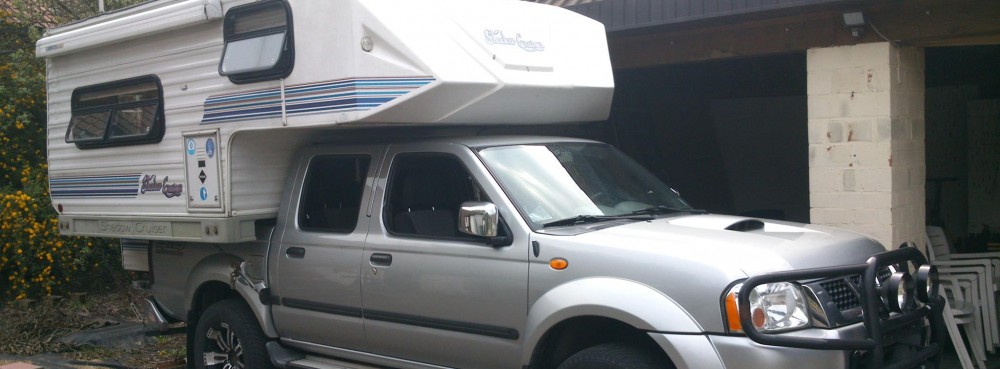
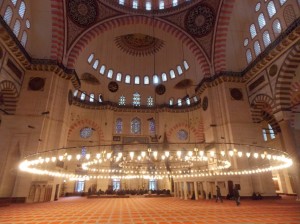
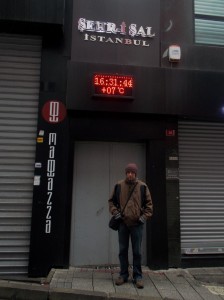
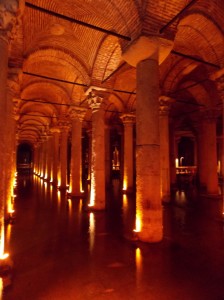
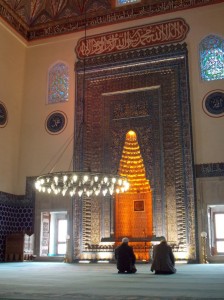

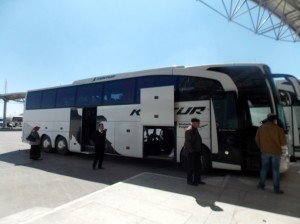

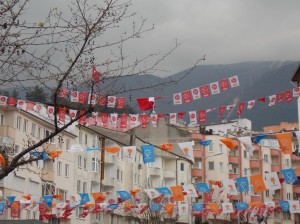
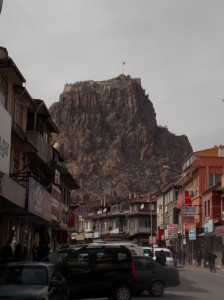
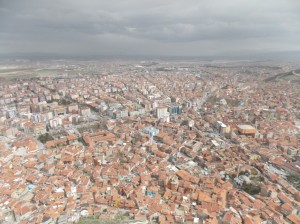
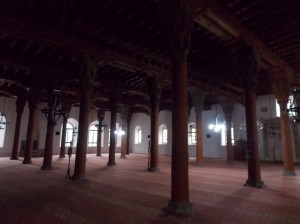
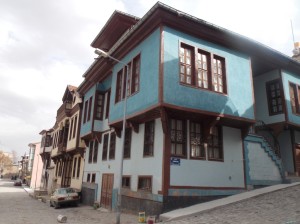
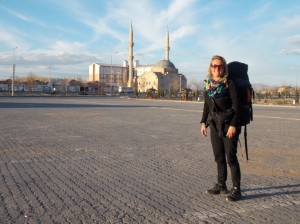
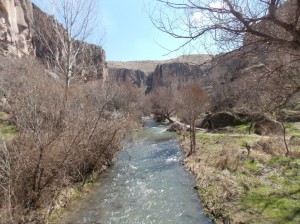
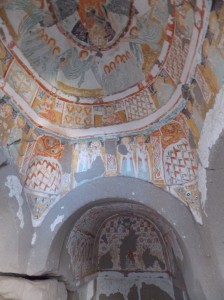
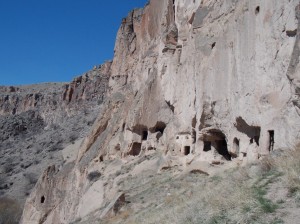
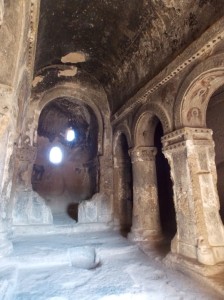
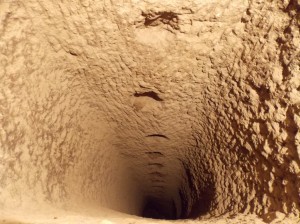
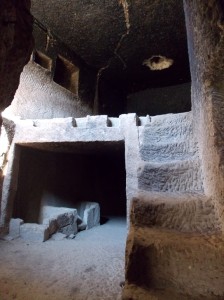

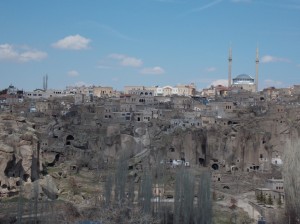
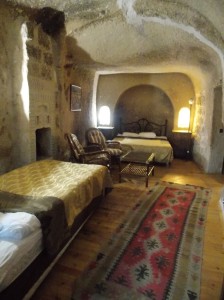
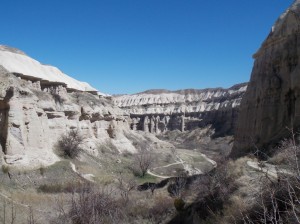
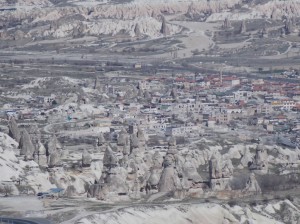
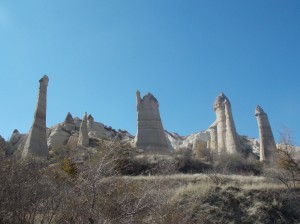
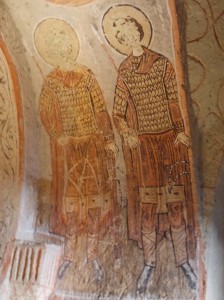
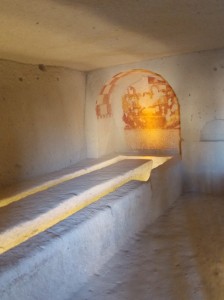
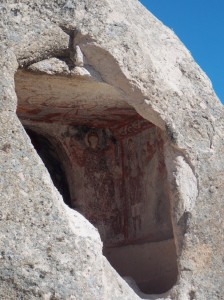
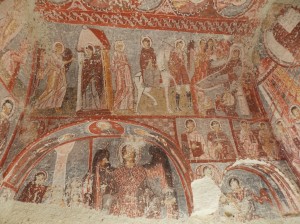
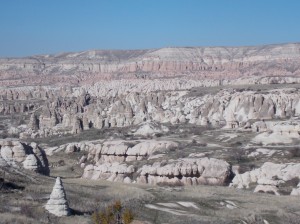
Mooi besproken,nog een goede tijd voor jullie gewenst.grts gino